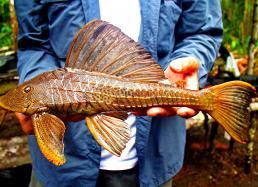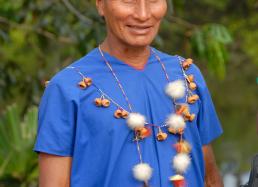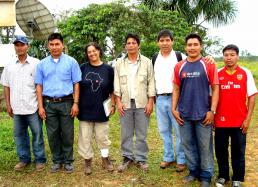10. Presenting to the Public
After a two-and-a-half hour flight from the military base near Tres Fronteras, we arrived in Iquitos. Everyone is thrilled to have showered, and most of us have scarfed down incredible quantities of food to try and begin recovering some of the weight we've lost.
We reunited with the social team, who spent the last three weeks visiting communities in the Napo and Putumayo drainages (see Photo #3 below.) Everyone—biologists, anthropologists, and social scientists—is sharing results, and it's amazing to pull everything together.
In three weeks, our team recorded more than 2,000 species: 1,400 plants, 184 fishes, 59 amphibians, 48 reptiles, 437 birds, and 46 medium and large mammals (see Photo #1 below.) These findings included new species (15 plants, 5 fishes, and 1 frog), species never registered before in Peru (7 plants, 6 fishes, and 1 frog), and species never registered before in Ecuador (9 plants, 17 fishes, and 2 frogs).
The social team visited 13 Peruvian communities (four on the Napo River and nine on the Putumayo River ) of Secoya, Kichwa, Huitoto, and mestizo peoples (see photo #2 below). Communities in both river drainages have well-established social traditions of management and environmental protection, as well as social and institutional assets that will enable and promote management and conservation.
Most of the population is involved in subsistence-level activities, with low-impact resource use and few links to markets. Nonetheless, both biological and cultural diversity are threatened by new resource-use patterns (e.g., timber, fishing, hydrocarbons) that endanger the abilities of communities to continue to protect their ways of life and the forest resources they depend on. To get a sense of the social inventory, check out “Video Report 2: Social Inventory."
For the next week, we'll focus on writing up our results, pulling together species lists, and writing the first version of our report. Simultaneously, we're working on a presentation of the results in three different cities! For these events, we invite decision-makers, non-governmental institutions, community organizations, local scientists, oil companies, timber barons, etc. Our goal is to convene as many of the stakeholders as possible and present our results and recommendations while they're as fresh as possible. Protecting this area is urgent, and the sooner we can get the results into the hands of people who make decisions, the better.
We'll present in Iquitos, and then fly to Peru’s capital, Lima, for our next presentation. From there, we fly back to Quito, Ecuador, where everything began a month ago. To see more about the recommendations we made during our presentations, please take a look at our Interactive Map—it contains details about our campsites and more photos of the plants and animals we discovered during our inventory. And to get an idea of the end products of our inventory, take a look at “Video Report #10: Rapid Inventory Results."
Stay tuned, as my next report will give you the details on how our work has proceeded back at home, and the progress we’ve made so far in our efforts to support coordinated management of the conservation corridor.
Corine
Written October 30, 2007







